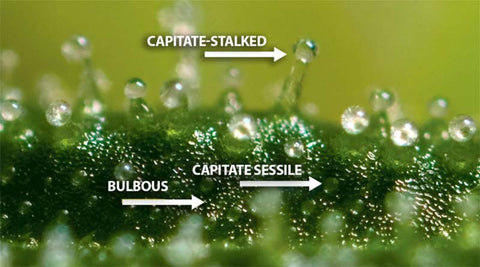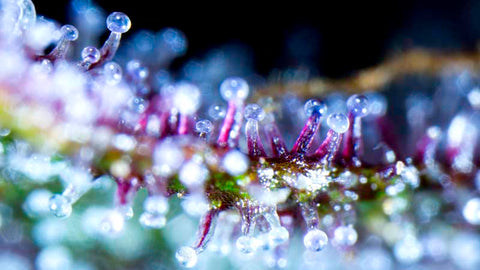Most likely, you’ve heard about the importance of Trichomes and why proper handling matters. Trichomes are minute, but can you imagine how they affect the buds? They’re a perfect example of how something so tiny, when put together, makes a significant impact. But what else should you know about these little plant parts?
What are Trichomes?
Trichomes are tiny outgrowths on a plant’s surface. While they are usually called microscopic hair, they can also be thorns.
In cannabis, trichomes are what store cannabinoids and terpenes. You can find them on the buds and leaves of a plant, and they have a crystalline appearance. A sign of good trichomes in cannabis is the sticky appearance. They can be hard to remove when trimming, which is why trimmers have non-stick surfaces to preserve the trichomes. When trichomes are abundant, it also means that a bud is more potent.
What Role Do Trichomes Play?
Trichomes in cannabis are a deterrent against pests, as they have strong scents and a bitter taste. They also serve as a shield against harmful environmental conditions, such as excessive UV rays, wind, and to some point, fungal growth. Trichomes serve as an optical filter that lessens the amount of UV rays that reach the plants. Because of these trichomes, your plants are protected from excess radiation by increasing the reflectance of light.
Trichomes are precious because they contain THC, which provides the psychoactive effects of cannabis. On their own, they do not have any psychoactive effects. You will need to heat the Trichomes to unlock the effects through decarboxylation.
The flavor of a bud is also affected by Trichome quality. While terpenes contain flavor profiles, you can find these terpenes stored in the Trichomes. That is why growers take extra care during harvest to preserve these trichomes, as they are responsible for the goodness in each bud.
Types of Trichomes
There are three types of trichomes in cannabis.
Bulbous Trichomes

The Bulbous trichomes measure 10 – 30 micrometers and are invisible to the naked eye. They contain cannabinoids and are often found on the leaves and stalks.
Capitate-sessile trichomes

Capitate-sessile trichomes are usually 25 – 100 micrometers in size and are also invisible to the naked eye. Like the Bulbous trichomes, the Capitate-sessile trichomes are also found on the stalks and leaves.
Capitate-stalked trichomes

The Capitate-stalked trichomes are more visible and are known for being the oil-rich trichome. This trichome becomes more dense in the flowering stage and is the basis for determining when cannabis is ready for harvest. This trichome is also rich in cannabinoids and terpenes.
While Bulbous and Capitate-sessile trichomes are in undesirable parts of the plant, some growers explore biomass processing to extract these trichomes to maximize a harvest.
When Do Trichomes Start Appearing?
Trichomes become more prominent during the third or fourth week of the flowering stage of your plants. It would be best to start inducing the nutrients your plants need to improve trichome production and effectiveness at this phase.
In the early stages of development, the Trichomes are at their most potent level and will look milky white in appearance. The Trichomes will then shift into an amber-like shade, producing sedative-like effects instead of being psychoactive. The best time to harvest buds is when they look milky white with little to no amber-like colors.
How Do You Improve Trichome Prooduction and Potency?
Better Trichomes start during the development of the cannabis plant. As a rule of thumb, high-quality trichomes start with the genetics of a plant. Right from the start, you need to choose a strain known for trichome abundance.
Proper nutrients during your plant’s development would be best for getting good trichomes. You can get better Trichomes with higher Phosphorus and Potassium levels during the flowering stage. But each plant will need a particular level, so there’s no one-size-fits-all solution on nutrient levels.
Lighting is also a crucial factor in trichome development. This is why cannabis grown near the equator is more resinous, because of the lighting conditions in these places. But that doesn’t mean you can’t do the same if living in a state far from the equator. More so, you can also replicate this even when growing indoors.
Luckily, many grow lights are now designed for full spectrum coverage. As trichomes develop during the flowering stage, your grow lights must be set for the flowering stage. As an added boost, consider using grow lights with UV coverage. While not fully proven, some growers deprive their plants of lighting in the last 48 hours before harvest to increase trichome production.
Consider adjusting humidity levels to 30-40 percent at 26 degrees Celsius. When humidity is low, plants are subjected to a more stressful environment, producing more trichomes as a defense mechanism. Temperature is also crucial as too hot or cold settings can affect trichome development and plant metabolism.
How Can You Tell When Trichomes are Ready?
Trichomes are the usual indicator to see if a plant is ready for harvest. If the Trichomes have gone from transparent to milky white, it’s time to start harvesting.
Note that not all Trichomes will look the same during harvest. Often, the upper portion of a plant will mature first due to being more exposed to light. That’s why you must harvest in batches to ensure all your buds are ready.
While harvesting is as easy as cutting off the stalks, reducing your buds from touching other surfaces is best. If you plan to trim before drying, immediately process it for trimming. Consider getting an efficient trimmer that has non-stick properties to preserve trichomes. For more information, you can read our article on harvesting here.
Conclusion
Trichomes are like the core of your buds. It’s what makes your cannabis powerful. Proper nurturing and handling go a long way, so understanding what Trichomes do for your plants helps you maximize your harvest.




